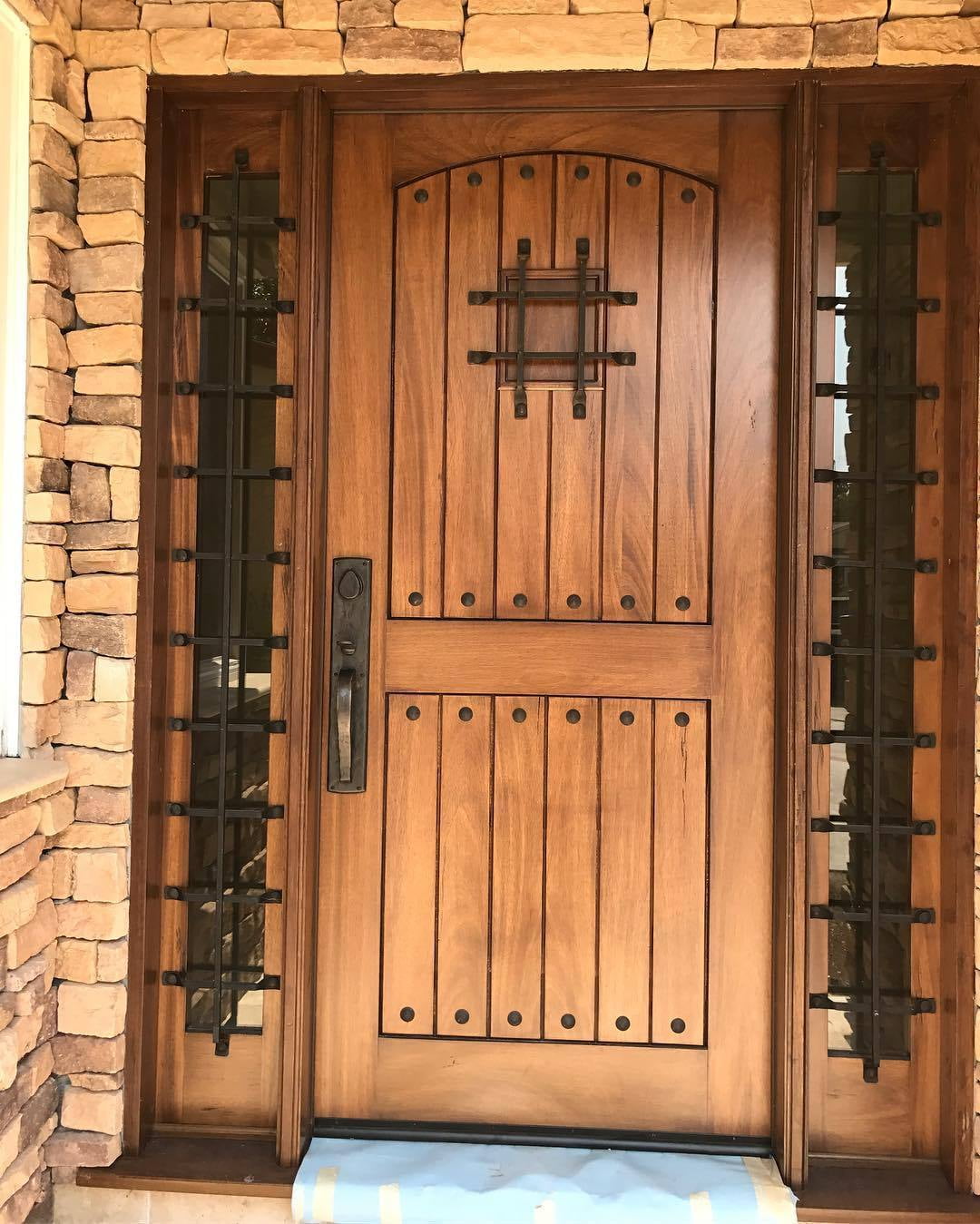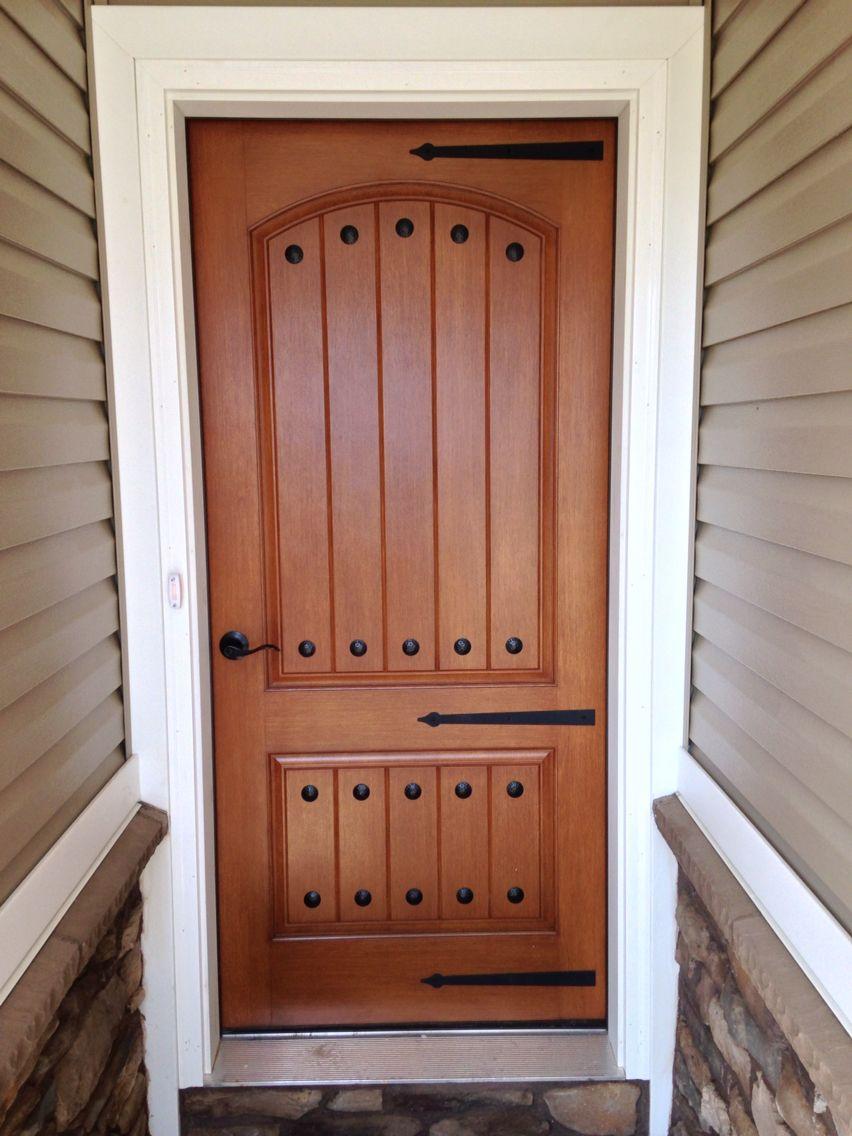you are planning to install a door with clavos chances are that you should read this post. Clavos are an admirable feature in the entrance door, particularly if the doors are made of glass. They represent a refinement and ornate style detail since they enhance functionality and aesthetics at the same time. But let’s be clear: a door with clavos does not make your home impenetrable. It is important to know that adding clavos to your door does not provide any special security features.

Doors with clavos
If you are looking for a new door or window, it’s time to get acquainted with clavos!
Clavos is a term that refers to a type of door and window. Clavos doors and windows have been used in Mexico since the 1500s and can be found throughout the country. The name clavo comes from the Spanish word “clavo”, which means nail.
There are many types of clavos:
Clavos de caracol or spiral nails – These are spiral-shaped nails that are placed in the middle of each plank. They are usually made from wood or metal.
Clavos de espiga or spike nails – These are two-pronged spikes that go into the top and bottom of each plank. They can also be made from wood or metal.
Clavos de madera or wooden nails – These nails are made from wood instead of metal or plastic and they have different designs depending on where they’re used on the door or window frame (for example, if they’re going into an interior wall).
Clavos are a type of door or window. They are made up of two or more boards that have been slightly bent and joined together at the top and bottom with wooden pegs, nails or metal strips called clavos.
Clavos can be seen on many types of doors and windows in Mexico. The clavos hold the boards together and prevent them from warping.
The word clavo has many different meanings in Spanish. It can mean nail or pin, but it can also mean splinter, thorn or burr. It is not clear why this word was used to name one part of a door frame, but it may have something to do with the fact that some pieces of wood were shaped like nails (with sharp points) when they were first put together.
There are many types of doors, windows and clavos. Here is a list of the most commonly used types:
Clavos (doors)
Clavos are doors that can be opened by hand or with a key. They are the oldest type of door, first appearing in Greece and Rome around 500 BC. Clavos were popular throughout Europe until the 16th century when they were superseded by more secure locks and hinges. Nowadays they are mainly used as decorations on buildings or as sliding doors in old-fashioned furniture such as wardrobes or bookshelves.
Door (doors)
A door is a panel which swings horizontally or vertically to cover an entrance to a building, room or other space. Doors usually consist of two panels: one that swings along an axis perpendicular to its plane; and another (hinge side) that does not move along any axis, but remains fixed against its plane and perpendicular to its surface, such as for example for fire protection reasons or to support a lintel above it (which may have no other function than that). Doors have been known since before written history; for example ancient Egyptians built them about 5000 years ago from wood planks hung from leather straps[1] or ropes[2]
Clavos are the small nails that are used to hold a wooden door. They are also called claves or clavos and can be made of iron or steel. Clavos have been used since ancient times, but they became more common in the 15th century when they were used to decorate doors.
Clavos can come in different shapes and sizes depending on their purpose. The most common type of clavo is the barrel head nail with three or four rectangular heads on a single shaft. The heads provide extra strength and support for the door when it is closed. The heads also help prevent damage to the wood by preventing excessive pressure from being applied directly onto the grain of the wood.
Clavos can be purchased at any home improvement store or hardware store and come in packages of 100 or more in varying lengths from 3/4″ (1-1/2 cm) up to 6″ (15 cm). They typically come in boxes with smaller nails for trim work around windows, doors and moldings as well as larger ones for use on interior and exterior doors.
The clavos is a type of door, made of wood and clavos. The clavos door is similar to the madera door, but it has less clavos on each side of the door. The clavos are used as a decoration to add style or design to the door.
The name comes from the Spanish word clavo: “nail”. It is also known as “door of nails” or “door nail” in some parts of Mexico.
The clavos door is divided into two parts: one part is placed on the frame or post, while the other part is placed on top of it. Each part has four holes where nails are inserted with no equal spacing between them.
There are many types of doors in Mexico with different designs and sizes. Some have square frames, others have rounded corners and some have rounded corners with decorative carvings on them.

Clavos in english
Clavos, or nails, is a general term for the different types of fasteners used in construction.
There are different kinds of nails. The most common are wood and metal, but there are also plastic and composite versions. Clavos can be used in a variety of ways: to secure walls to framing, as casement or transom stops or shutter hinges, or as decorative trim.
The price for clavos varies depending on the type and size you need. For example, a box of 100 2-inch galvanized steel brads costs $20 at home depot, but if you buy them by the pound (about 500), it’s about $0.40 per brad.
Clavos are a type of door and window fastener made of iron or steel that is secured with a hammer. They are similar to nails, but have wider heads and more rounded points.
Clavos can be used for many projects around the home, including hanging pictures, attaching molding and repairing furniture. They are also used in carpentry as an alternative to nails or screws when making joints or fastening two pieces together. Clavos provide extra strength because they go into the wood at an angle instead of straight down like a nail does.
When selecting clavos, choose ones with large heads so they will not split the wood when hammered into place. The larger the head size on your clavos, the greater force will be needed to drive them into place; this means that smaller head sizes require less hammering power but may be harder to remove once installed.
There are several types of clavos available for purchase at your local home improvement store or lumberyard:
Wedge-head Clavos: wedge-head clavos have flat heads that are slightly wider than their shanks (the part that goes into the wood). You can use these in hardwood floors if you need to attach molding; however
The clavos is a piece of wood placed on the top of a door or window to prevent it from opening. This is a very common feature in Mexico and South America, where many houses have windows that open outwards.
The clavos is usually made of oak, but can also be made from other types of wood. Clavos are often decorated with carvings or paint.
There are many different types of clavos:
Clavo de madera: These are simple wooden clavos used widely throughout Mexico, Central America and South America. They can be painted or left unpainted. They are usually about 3-4 inches long, although there are longer versions available for doors that need more support
Clavo de madera con cabeza: These are similar to the above type but have a head at one end so that they can be hammered into place without splitting the wood.
Clavo de madera con cabeza llana: Similar to the above type but without any decoration on the head; these are used when there is insufficient room for decoration on the head.
Clavos are a type of nail with a large head, typically used to secure the planks of siding called cladding on a house. Clavos can be made from metal or wood, and they’re generally used to hold siding on a structure permanently.
Clavos come in different sizes and shapes, so before you begin working, it’s important to measure the space where you’ll be installing your clavos. Use a tape measure to measure the area where you want to install clavos, then subtract 1/4 inch from each measurement so that you have room for the heads of the nails when you install them.
Clavos is a type of nail used in construction and carpentry. They come in various sizes and shapes, but their purpose is the same: to affix one material to another.
Clavos are typically used for attaching wood to a wall or board. They are also used to secure metal studs to the foundation of a house, as well as on roofs where they can be driven through shingles or felt paper and into the sub-roofing material.
Clavos are typically made of metal, but they can also be made from plastic or wood. The type of clavo used depends on the material being joined together and what kind of job it needs to do.
